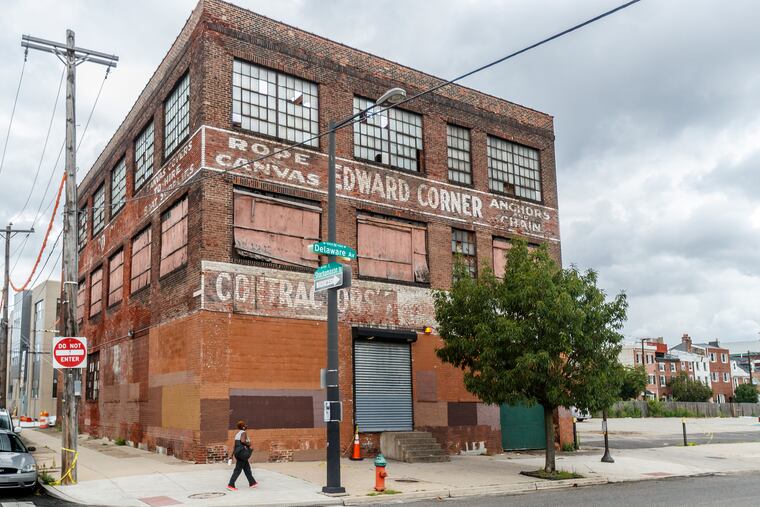The Edward Corner building’s journey from rags to real estate riches in Fishtown
The future looks good for one of the last architectural vestiges of Philadelphia's maritime history.

If you want to track Fishtown’s evolution from Philadelphia’s maritime center to the city’s trendiest neighborhood, look no further than the Edward Corner warehouse on Delaware Avenue.
Famous today for its faded signs that advertise rope and canvas, the small industrial building went up in 1921, the year the city widened the northern stretch of Delaware Avenue to encourage the growth of its port. The building fell into disuse in the ‘60s, as the port shifted south to accommodate containerization. Now, having sat empty and forlorn for half a century, its signs becoming ever more ghostly, the brick warehouse is about to get a new life as the headquarters of an up-and-coming real estate developer.
The Edward Corner Marine Merchandise Warehouse, as it is formally known, is named after the company’s founder, an English immigrant who arrived in America in 1859 and made his living as a junk dealer, according to Oscar Beisert, a preservation activist who successfully nominated the warehouse for the city’s Historic Register in 2015. Corner collected rags and other discards, which he recycled into salable products. It wasn’t unusual at the time for newcomers to make a living this way, and Corner prospered. By 1873, Corner and his partner, William J. Keighley, had established a warehouse on Beach Street, across from where Penn Treaty Park now stands.
Being near the city’s expanding docklands was good for business. The city’s biggest boat builder, the Cramp Shipyard, was just a few blocks upriver, and dozens of factories congregated nearby. All those manufacturers needed rags to clean their machinery. After Corner’s sons, Edward L. and William D., took over the business in 1903, they added recycled rope and string to the company’s product line.
But the rapid growth of the city’s maritime economy put a severe strain on Delaware Avenue, then a narrow city street. The city decided to widen the street and extend the new boulevard into Fishtown and Port Richmond. Work got as far as Fairmount Avenue when World War I broke out, but it was clear that the Corner brothers’ Beach Street warehouse would soon be displaced. Once the city resumed construction in 1920, they purchased a site facing the new Delaware Avenue at Shackamaxon Street and hired architect A. Raymond Roff to design a modern warehouse.
There is nothing particularly remarkable about the three-story brick structure, which resembles dozens of Philadelphia warehouses. But the Corners had a knack for self-promotion, and soon began using the building as a canvas to advertise their business. The walls are inscribed with lists of their products: rope, canvas covers, boat and ship supplies, blasting materials. “We buy old rope,” one of the signs declares.
Pedestrian and truck traffic were constant along Delaware Avenue. The sprawling Jack Frost Sugar Refinery — now SugarHouse Casino — was across the street from the Corners’ warehouse. Before the construction of I-95 in the ‘60s, the area between Girard and Delaware Avenues was packed tight with rowhouses, and Fishtowners would have been able to walk easily to the docks.
But even before the highway cut a swath through the neighborhood, there were signs that the heyday of Fishtown’s docklands was passing. Cramp Shipyard shut down in 1947 and other factories were dying off. After Edward L. Corner died in 1955, the family seems to have lost interest in the rag business. In 1960, the surviving Corners sold the building to the Scandinavian Ship Supply Co. That didn’t last, and the building ended up as a furniture warehouse.
As the waterfront declined, so did the Edward Corner building. Hopes for a renovation rose when the developer Michael Samschick acquired the building in the early 2000s. Instead, the Corner warehouse languished while he put his efforts into renovating the nearby Ajax Metal Factory, now the home of the Fillmore music hall.
Even after Beisert succeeded in getting the building historic status in 2015, it looked as if the sagging warehouse might not survive. Arguing that the building was too expensive to renovate on its own, Samschick persuaded the Historical Commission in 2017 to allow him to add three more floors for apartments.
Nothing happened. Instead, the warehouse sat empty until Streamline, a Philadelphia real estate developer, acquired it, with the aim of turning it into the company’s headquarters. Work is now underway, and Streamline vice president Steve Kosloski said he is determined to hold the company Christmas party there.
It will take careful construction to shore up the 17-inch-thick, load-bearing brick walls, while preserving Edward Corner’s signature feature, its faded ghost signs. Since the warehouse is a protected building, Historical Commission staff will be overseeing the renovation, which has been designed by Harman Deutsch Ohler Architecture. At this point, the plan is to leave the painted signs as is and repoint the bricks with a complementary mortar, much as the firm did at MilkBoy on Chestnut Street.
Much like the famous PSFS lights on top of the Loews Hotel, the Corner building’s phantom signs serve as evocative memorial to a Philadelphia that no longer exists, but is very much worth remembering.